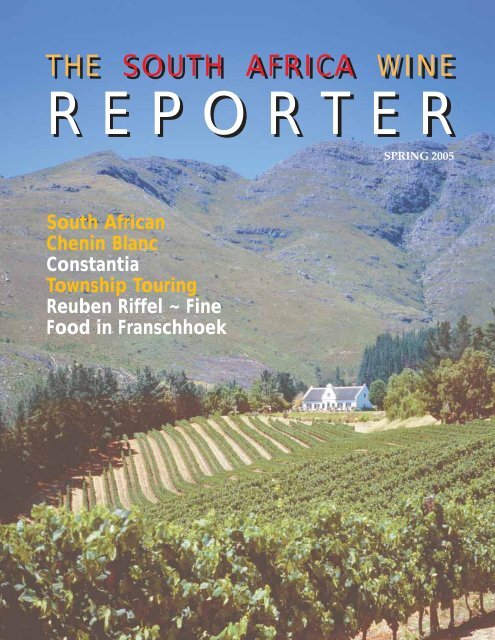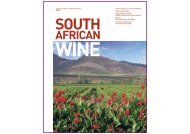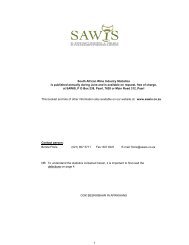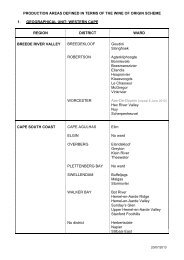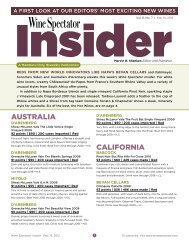the south africa wine the south africa wine - Wines of South Africa
the south africa wine the south africa wine - Wines of South Africa
the south africa wine the south africa wine - Wines of South Africa
Create successful ePaper yourself
Turn your PDF publications into a flip-book with our unique Google optimized e-Paper software.
THE SOUTH AFRICA WINE<br />
REPORTER<br />
SPRING 2005<br />
<strong>South</strong> <strong>Africa</strong>n<br />
Chenin Blanc<br />
Constantia<br />
Township Touring<br />
Reuben Riffel ~ Fine<br />
Food in Franschhoek
S O U T H A F R I C A W I N E R E P OR T E R N O R T H A M E R I C A<br />
contents SPRING<br />
2005<br />
Augusta <strong>wine</strong>ry in Franschhoek<br />
1 News & Views<br />
2 <strong>South</strong> <strong>Africa</strong>n Chenin Blanc:<br />
On <strong>the</strong> Fast Track from om Work-<br />
horse to Thoroughbr<br />
oughbred<br />
ed, by<br />
Michael Franz<br />
8 Constantia:Thinking Small<br />
Pays Big Dividends, by Kim<br />
Maxwell<br />
10 Township Touring: Growth,<br />
Diversity and Sense <strong>of</strong> Place,<br />
by Suzanne Morton<br />
12 Reuben Riffel fel ~ Fine Food in<br />
Franschhoek, by Cinda Chavich<br />
In our spring issue, renowned<br />
<strong>wine</strong> journalist Michael Franz<br />
shows us why <strong>South</strong> <strong>Africa</strong> is<br />
poised to establish <strong>the</strong> reputation<br />
<strong>of</strong> Chenin Blanc as a superb <strong>wine</strong><br />
grape. Our regional focus is<br />
Constantia, which may be small<br />
in size but certainly tremendous<br />
in quality. Our new marketing<br />
manager for North America,<br />
Suzanne Morton, gives a<br />
fascinating glimpse <strong>of</strong> <strong>South</strong><br />
<strong>Africa</strong> in her Township Touring<br />
piece. Finally, we check in on <strong>the</strong><br />
<strong>South</strong> <strong>Africa</strong>n culinary scene, in<br />
an interview with <strong>the</strong> up-andcoming<br />
chef Reuben Riffel.<br />
THE SOUTH AFRICA WINE REPORTER<br />
a<br />
THE SOUTH AFRICA WINE<br />
REPORTER<br />
Editor-in-Chief: Suzanne Morton<br />
Managing Editor: Carole Cleaver<br />
Associate Editor: Rory Callahan<br />
WINES OF SOUTH<br />
AFRICA<br />
CEO: Su Birch<br />
Marketing Manager for North<br />
America: Suzanne Morton<br />
Head Office:<br />
fice:<br />
8 Helderberg Road,<br />
Stellenbosch 7599, <strong>South</strong> <strong>Africa</strong><br />
Tel: +27 (21) 883-3860<br />
info@wosa.co.za<br />
www.wosa.co.za<br />
United States Office:<br />
fice:<br />
c/o Wine & Food Associates<br />
799 Broadway, Ste 306<br />
New York, NY 10003<br />
Tel: (212) 505-1616<br />
info@<strong>wine</strong>s<strong>of</strong><strong>south</strong><strong>africa</strong>.net<br />
www.<strong>wine</strong>s<strong>of</strong><strong>south</strong><strong>africa</strong>.net<br />
Canadian Office:<br />
fice:<br />
c/o Propeller Communications<br />
2255b Queen St East Ste 302<br />
Toronto, Ontario M4E 2G1,Canada<br />
Tel: (416) 698-8112<br />
keenan@propellerpr.com<br />
www.<strong>wine</strong>s<strong>of</strong><strong>south</strong><strong>africa</strong>.ca<br />
For a free subscription to<br />
The <strong>South</strong> <strong>Africa</strong> Wine Reporter,<br />
please email your mailing address<br />
to info@<strong>wine</strong>s<strong>of</strong><strong>south</strong><strong>africa</strong>.net
n e w s & v i e w s<br />
Franschhoek<br />
VANCOUVER PLAYHOUSE WINE FESTIVAL TO<br />
FEATURE SOUTH AFRICAN WINES<br />
From March 14-20, The Vancouver Playhouse<br />
International national Wine ine Festival, a fundraising event for<br />
<strong>the</strong> renowned Vancouver Playhouse, will present its<br />
27th annual week <strong>of</strong> special events dedicated to <strong>wine</strong><br />
and food. <strong>South</strong> <strong>Africa</strong> is <strong>the</strong> <strong>the</strong>me region this year,<br />
showcasing 31 <strong>wine</strong>ries from across <strong>the</strong> Cape. In<br />
addition to <strong>the</strong> International Festival Tasting room<br />
where all <strong>the</strong> <strong>South</strong> <strong>Africa</strong>n <strong>wine</strong>ries will be showcasing<br />
<strong>the</strong>ir <strong>wine</strong>s, <strong>the</strong>re are 11 <strong>South</strong> <strong>Africa</strong> <strong>the</strong>med events,<br />
including ‘Celebrate <strong>the</strong> Cape’, a Saturday afternoon<br />
food and <strong>wine</strong> pairing event accompanied by music<br />
and dancing from <strong>South</strong> <strong>Africa</strong>. For fur<strong>the</strong>r<br />
information, please visit www.playhouse<strong>wine</strong><br />
fest.com.<br />
SAWIS REPORTS GROWTH IN WINE EXPORTS<br />
TO US IN 2004<br />
Recent figures released by <strong>the</strong> <strong>South</strong> <strong>Africa</strong>n Wine<br />
Industry Information & Systems (SAWIS)<br />
show an<br />
encouraging growth in <strong>wine</strong> exports to <strong>the</strong> US for 2004.<br />
Total exports <strong>of</strong> bottled <strong>wine</strong> went up from 539,405 9-<br />
liter cases in 2003 to 858,860 9-liter cases in 2004, a<br />
59% increase<br />
ease. WOSA is expanding its presence in <strong>the</strong><br />
US this year, increasing funding to <strong>the</strong> same levels<br />
allocated to <strong>the</strong> UK market, <strong>the</strong> biggest export destination<br />
thus far for SA <strong>wine</strong>s.<br />
RECENT STUDY SHOWS SA WINE INDUSTRY BEST<br />
SUITED TO PREMIUM WINES<br />
A new study <strong>of</strong> <strong>the</strong> international cost-<br />
competitiveness <strong>of</strong> <strong>the</strong> <strong>South</strong> <strong>Africa</strong>n <strong>wine</strong> industry<br />
shows that <strong>the</strong> decision to focus more on marketing<br />
premium and luxury y <strong>wine</strong>s is <strong>the</strong> right route to follow.<br />
Commissioned by WOSA, <strong>the</strong> research was carried<br />
out by business analyst James Herrick, who looked at<br />
<strong>South</strong> <strong>Africa</strong>n <strong>wine</strong> production costs in relation to those<br />
in Australia and France. His findings suggest that <strong>South</strong><br />
<strong>Africa</strong> performs best in an environment <strong>of</strong> mediumor<br />
high-cost <strong>wine</strong> farming, and that <strong>the</strong> country’s <strong>wine</strong>s<br />
will be globally cost-competitive at <strong>the</strong> higher end <strong>of</strong><br />
<strong>the</strong> spectrum ra<strong>the</strong>r than in <strong>the</strong> value segment, where<br />
Australia fares significantly better.<br />
US WINE CONSUMPTION GROWS<br />
Last year, US <strong>wine</strong> consumption totalled 278 million<br />
9-liter cases, according to <strong>wine</strong> market specialist Jon<br />
Fredrikson <strong>of</strong> Gomberg, Fredrikson Associates.<br />
Imports accounted for 26% <strong>of</strong> sales, reaching a record<br />
level <strong>of</strong> 72 million cases. Now, an international <strong>wine</strong><br />
market study (International Wine & Spirits Record)<br />
projects that total <strong>wine</strong> sales volumes in <strong>the</strong> US will<br />
increase to 410 million cases by 2008, valued at<br />
US$ 24 billion and making it <strong>the</strong> world’s largest <strong>wine</strong>consuming<br />
nation. <strong>South</strong> <strong>Africa</strong> currently has 2.6%<br />
<strong>of</strong> <strong>the</strong> New World volume share in <strong>the</strong> US, worth<br />
US $30 million.<br />
THE SOUTH AFRICA WINE REPORTER<br />
1<br />
a
Chenin Blanc<br />
ON THE FAST TRACK FROM<br />
WORKHORSE TO THOROUGHBRED<br />
By Michael Franz<br />
Chenin Blanc gets more than its share <strong>of</strong> bad<br />
press but we should remember that every<br />
grape variety bearing <strong>the</strong> capacity to make great<br />
<strong>wine</strong>s with distinctive character must also bear <strong>the</strong><br />
occasional insult.<br />
Sauvignon Blanc’s detractors call it pungent and<br />
shrill. Cabernet’s critics chide it for being angular and<br />
hard, and Merlot gets maligned for being gutless and<br />
facile. However, anyone with a fair mind and an experienced<br />
palate knows that <strong>the</strong>se are great grapes,<br />
and that <strong>the</strong>ir greatness is undiminished by <strong>the</strong> fact<br />
that a partisan critic could point to plenty <strong>of</strong> poor renditions.<br />
If you’ve tasted just one great bottle <strong>of</strong> Latour<br />
or Petrus, no one will ever be able to convince you<br />
that Cabernet or Merlot is a second-rate variety.<br />
Chenin Blanc belongs in this league <strong>of</strong> great<br />
grapes, but its greatness is underappreciated for two<br />
key reasons. First, its reputation suffers from <strong>the</strong> sad<br />
fact that many Chenins made around <strong>the</strong> world really<br />
are boringly bland or downright <strong>of</strong>fensive.<br />
Second, few consumers have tasted a truly great<br />
Chenin Blanc that could immunize <strong>the</strong>ir opinion <strong>of</strong><br />
<strong>the</strong> grape against all <strong>of</strong> those bland or <strong>of</strong>fensive renditions.<br />
Excellent Chenins have generally trickled into<br />
world markets from only one tributary — France’s<br />
Loire Valley.<br />
That, however, has changed. During <strong>the</strong> past<br />
dozen years or so, many <strong>South</strong> <strong>Africa</strong>n vintners have<br />
heightened <strong>the</strong> seriousness with which <strong>the</strong>y craft<br />
Chenin Blanc, and <strong>the</strong> delicious <strong>wine</strong>s <strong>the</strong>y are now<br />
exporting will help teach <strong>the</strong> world an important lesson<br />
about <strong>the</strong> heights this grape can reach.<br />
cow. Its natural attributes suit it to <strong>the</strong>se inglorious<br />
roles (and all-too-well, for <strong>the</strong> sake <strong>of</strong> its reputation).<br />
Vigorous in growth and abundant in yield, Chenin vines<br />
are also resistant to heat, wind, and many maladies<br />
and pests that afflict o<strong>the</strong>r varieties.<br />
Consequently, virtually every country and region<br />
that has planted Chenin Blanc has employed this hardy,<br />
heavy-bearing variety as a base for vin ordinaire. This<br />
is emphatically <strong>the</strong> case in California, where yields in<br />
<strong>the</strong> hot Central Valley are cranked up as high as 10<br />
tons per acre (or 175 hectoliters per hectare). Much<br />
<strong>the</strong> same is true elsewhere in <strong>the</strong> United States, as<br />
well as in Mexico, Brazil, Chile, Argentina, Uruguay,<br />
Australia and New Zealand.<br />
Historically, <strong>wine</strong>growers in <strong>South</strong> <strong>Africa</strong> have also<br />
been quite content to exploit Chenin’s productivity. It<br />
is widely believed that<br />
Chenin was<br />
2<br />
a<br />
MORE THAN VIN ORDINAIRE<br />
Those who fail to recognize Chenin Blanc as a<br />
thoroughbred can be excused on <strong>the</strong> ground that it is<br />
most <strong>of</strong>ten employed as a workhorse or even a cash<br />
THE SOUTH AFRICA WINE REPORTER
among <strong>the</strong> first bundles <strong>of</strong> vine cuttings imported by<br />
industry pioneer Jan van Riebeeck in 1655, along with<br />
Semillon (or Groendruif) and Listan, which is better<br />
known as Palomino in Spain. Chenin has played a<br />
major role in <strong>South</strong> <strong>Africa</strong>n viticulture ever since.<br />
The grape was known as ‘Steen’ from early on,<br />
and <strong>the</strong> name persists as a synonym to this day. The<br />
leading <strong>the</strong>ory attributes this to confusion between<br />
grapes, followed by Dutch settlers transforming <strong>the</strong><br />
French word ‘Listan’ to ‘La Stan,’ <strong>the</strong>n to ‘De Steen’,<br />
and finally to ‘Steen.’ Long thought to be <strong>of</strong> Germanic<br />
origin, Steen was not reconnected to its European<br />
source until 1963, when viticulture pr<strong>of</strong>essor<br />
C.J. Orffer from <strong>the</strong> University <strong>of</strong> Stellenbosch definitively<br />
identified Steen as Chenin Blanc.<br />
Chenin Blanc’s identity may have remained unclear<br />
for centuries in <strong>South</strong> <strong>Africa</strong>, but its strong and versatile<br />
performance characteristics were apparently clear from<br />
<strong>the</strong> outset. Chenin fared particularly well once planted,<br />
handling all <strong>the</strong> viticultural challenges thrown its way<br />
in <strong>the</strong> broader Cape region. Its performance in <strong>the</strong><br />
cellar was at least as strong as in <strong>the</strong> vineyard and<br />
enterprising <strong>South</strong> <strong>Africa</strong>ns found it suitable not only<br />
for all manner <strong>of</strong> sweet, dry and sparkling <strong>wine</strong>s but<br />
also for a wide range <strong>of</strong> fortified <strong>wine</strong>s and spirits.<br />
Thanks to its resilience and versatility, Chenin Blanc<br />
was <strong>South</strong> <strong>Africa</strong>’s most widely planted variety when<br />
<strong>the</strong> country resumed exports to all global markets in<br />
<strong>the</strong> early 1990s. With over 30,000 hectares (or 70,000<br />
acres) devoted to it, Chenin claimed more than a third<br />
<strong>of</strong> <strong>South</strong> <strong>Africa</strong>’s vineyard area.<br />
NO MARKET FOR SERIOUS CHENIN BLANC<br />
There was, however, one thing that <strong>South</strong> <strong>Africa</strong>n<br />
Chenin Blanc could not claim in <strong>the</strong> early 1990s: Greatness.<br />
Consumers within and beyond <strong>South</strong> <strong>Africa</strong><br />
tended overwhelmingly to regard <strong>the</strong> grape with indifference,<br />
with <strong>the</strong> result that no real market existed<br />
for serious renditions <strong>of</strong> this cultivar.<br />
Indifference among consumers is easy enough<br />
to understand. If <strong>South</strong> <strong>Africa</strong> was guilty <strong>of</strong> treating<br />
Chenin as a workhorse, so too were all <strong>of</strong> <strong>the</strong> o<strong>the</strong>r<br />
countries working with it outside <strong>of</strong> France. One or<br />
two vintners in each country were trying to get<br />
something special out <strong>of</strong> <strong>the</strong> grape, but <strong>the</strong>ir efforts<br />
hardly attained a critical mass that could impact global<br />
perceptions.<br />
Within France, serious regard for Chenin never<br />
waned, at least among <strong>the</strong> most conscientious<br />
vignerons. However, even in <strong>the</strong> Loire, a candid<br />
appraisal reveals that truly great Chenins are only made<br />
in small quantities by relatively few producers and in<br />
favorable growing seasons — which are anything but<br />
routine in <strong>the</strong> Anjou-Touraine region. Great renditions<br />
are vastly outnumbered by négociant bottlings that<br />
are correct at best and, at worst, sulfurous, sugary,<br />
sharp or dirty.<br />
Where global perceptions among consumers are<br />
concerned, <strong>the</strong>re is also <strong>the</strong> major problem that great<br />
examples from <strong>the</strong> Loire do not carry <strong>the</strong> name Chenin<br />
Blanc — much less Steen. It is only <strong>the</strong> rare connoisseur<br />
and not <strong>the</strong> average <strong>wine</strong> shopper (even within<br />
France itself) who knows ❂ anything substantial about<br />
Savennières, Coteaux du Layon, Bonnezeaux, Quartsde-Chaume,<br />
Montlouis or Jasnières.<br />
Few consumers know <strong>the</strong>se appellations, and<br />
fewer still know that Chenin Blanc is <strong>the</strong> grape behind<br />
<strong>the</strong>m. More know <strong>of</strong> Vouvray, but Vouvray is made<br />
in so many styles that it hardly helps fix Chenin’s pr<strong>of</strong>ile<br />
for consumers. And <strong>the</strong>re is also <strong>the</strong> problem that many<br />
<strong>of</strong> <strong>the</strong> sulfurous, sharp bottlings that drag down<br />
perceptions are precisely négociant Vouvrays.<br />
This, <strong>the</strong>n, was <strong>the</strong> grim situation<br />
confronting <strong>South</strong> <strong>Africa</strong>n producers in <strong>the</strong> early<br />
1990s. International markets were unknowing<br />
or unenthusiastic about Chenin or Steen, and<br />
domestic consumers regarded <strong>the</strong> <strong>wine</strong>s as bland stuff<br />
THE SOUTH AFRICA WINE REPORTER<br />
3<br />
a
unbefitting a special occasion or even a moderate price.<br />
This depressed prices for Chenin grapes within <strong>the</strong><br />
<strong>wine</strong> trade, prompting some producers to compensate<br />
by bumping up crop yields to levels that fur<strong>the</strong>r<br />
aggravated <strong>the</strong> blandness problem. O<strong>the</strong>rs cut bait<br />
on Chenin Blanc altoge<strong>the</strong>r, turning <strong>the</strong>ir attention<br />
toward Chardonnay or Sauvignon Blanc.<br />
POTENTIAL GREATNESS<br />
Chenin Blanc had nowhere to go but up in 1995. But<br />
up it came, thanks to <strong>the</strong> fact that potential greatness<br />
confers a certain buoyancy upon a grape that nei<strong>the</strong>r<br />
historical nor commercial misfortune can deflate.<br />
An initial impetus for taking Chenin more seriously<br />
was exerted in 1995 when a group <strong>of</strong> British Masters<br />
<strong>of</strong> Wine visited <strong>the</strong> Cape region. By all accounts, <strong>the</strong><br />
MWs expressed admiration for <strong>the</strong> best <strong>South</strong> <strong>Africa</strong>n<br />
Chenins — but also dismay that so many fine grapes<br />
were being lost by inclusion in mediocre, multi-variety<br />
blends.<br />
Encouragement from this contingent to take<br />
Chenin more seriously had an almost immediate effect<br />
on several different fronts. Masters <strong>of</strong> Wine based<br />
around <strong>the</strong> Cape organized a Chenin Blanc Symposium<br />
in 1996 that facilitated an exchange <strong>of</strong> technical<br />
information while also greatly enhancing general<br />
enthusiasm for <strong>the</strong> grape among producers.<br />
Perhaps <strong>the</strong> most significant development was <strong>the</strong><br />
formation <strong>of</strong> <strong>the</strong> Chenin Blanc Association, a<br />
cooperative endeavor <strong>of</strong> more than 65 producers<br />
devoted to enhancing both <strong>the</strong> quality and image <strong>of</strong><br />
<strong>the</strong> variety. By providing strategic guidance, tactics<br />
for marketing, and technical assistance regarding<br />
viticultural and <strong>wine</strong>-making practices, <strong>the</strong> Chenin<br />
Blanc Association has provided a highly dynamic core<br />
for <strong>the</strong> general effort to actualize all <strong>of</strong> <strong>the</strong> grape’s<br />
strong latent potential in <strong>South</strong> <strong>Africa</strong>.<br />
Several changes in vineyards and <strong>wine</strong>ries seem<br />
to provide <strong>the</strong> keys to unlocking that potential. The<br />
most important involves recognition that yields must<br />
be restricted. A related recognition is that old, lowyielding,<br />
head-pruned ‘bush’ vines should be treasured<br />
ra<strong>the</strong>r than spurned on account <strong>of</strong> <strong>the</strong>ir meager but<br />
high quality fruit. Additionally, yields are being<br />
restricted for younger vines by means <strong>of</strong> more rigorous<br />
pruning. Many producers are also picking Chenin at a<br />
later, riper stage to assure full flavor development.<br />
In <strong>wine</strong>making circles, a great deal <strong>of</strong> experimentation<br />
has been undertaken with oak, including both<br />
4<br />
a<br />
THE SOUTH AFRICA WINE REPORTER
new and more mature wood (used for fermentation,<br />
for aging, or for both). Whe<strong>the</strong>r <strong>the</strong> effects <strong>of</strong> oak<br />
are appropriate for <strong>South</strong> <strong>Africa</strong>n Chenin remains a<br />
hot topic <strong>of</strong> controversy. However, <strong>the</strong>re can be no<br />
question that <strong>the</strong>se experiments have greatly diversified<br />
<strong>the</strong> range <strong>of</strong> <strong>wine</strong>s now available to consumers,<br />
and one also senses that <strong>the</strong> controversy itself has<br />
pushed <strong>wine</strong>makers from all camps to intensify <strong>the</strong>ir<br />
efforts to provide exemplary <strong>wine</strong>s as representatives<br />
for <strong>the</strong>ir preferred pr<strong>of</strong>ile.<br />
The delightful result <strong>of</strong> all <strong>of</strong> this is that we now<br />
have access to a broad set <strong>of</strong> <strong>wine</strong>s displaying all <strong>the</strong><br />
different dimensions <strong>of</strong> which Chenin Blanc is capable.<br />
The grape can make very fine sparkling <strong>wine</strong>s and<br />
<strong>the</strong>se remain especially important in <strong>the</strong> domestic<br />
market. Among still table <strong>wine</strong>s, some are impeccably<br />
dry, featuring fresh primary fruit with crisp acidity.<br />
O<strong>the</strong>rs are fuller and riper but still based squarely on<br />
character drawn from fruit ra<strong>the</strong>r than oak. Ano<strong>the</strong>r<br />
style shares <strong>the</strong> fuller, riper pr<strong>of</strong>ile but seeks to augment<br />
fruit notes with spicy, smoky accents from oak.<br />
Yet ano<strong>the</strong>r important style is based on overt but<br />
not assertive sweetness drawn from residual sugar levels<br />
<strong>of</strong> 30 grams per liter or less. Seriously sweet dessert <strong>wine</strong>s<br />
are also being turned out with great success and <strong>the</strong> sky<br />
is <strong>the</strong> limit for residual sugar in <strong>the</strong>se bottlings.<br />
Almost all <strong>of</strong> <strong>the</strong> different styles now on <strong>the</strong> market<br />
are rounder in texture and less acidic than <strong>the</strong>ir famous<br />
Loire counterparts. They are certainly not inherently<br />
inferior for this reason but ra<strong>the</strong>r distinctively specific to<br />
<strong>the</strong>ir place <strong>of</strong> origin — as befits a great rendition <strong>of</strong> a<br />
great grape. And with two superb sources now sending<br />
delicious renditions into world markets, we can look<br />
forward to a future in which French and <strong>South</strong> <strong>Africa</strong>n<br />
<strong>wine</strong>s cooperate to return Chenin Blanc to its rightful<br />
rank among <strong>the</strong> world’s best and most widely admired<br />
<strong>wine</strong>s.<br />
Michael Franz is a <strong>wine</strong> writer, educator and consultant.<br />
He has written as Wine Columnist for The Washington<br />
Post since 1994. He also contributes articles on <strong>wine</strong> to<br />
several international <strong>wine</strong> magazines, conducts tastings<br />
and seminars for consumers and members <strong>of</strong> <strong>the</strong> <strong>wine</strong><br />
trade across <strong>the</strong> United States, and works as a consultant<br />
for 11 restaurants.<br />
THE SOUTH AFRICA WINE REPORTER<br />
5<br />
a
Constantia<br />
REGIONAL FOCUS<br />
6<br />
a<br />
One <strong>of</strong> <strong>the</strong> Cape’s smallest and oldest viticultural areas,<br />
Constantia is pro<strong>of</strong> that thinking small can pay dividends.<br />
Renowned for quality white and dessert <strong>wine</strong>s, Constantia<br />
also produces some red <strong>wine</strong>s <strong>of</strong> distinction.<br />
Kim Maxwell maps out <strong>the</strong> key features.<br />
Anybody who believes that <strong>South</strong> <strong>Africa</strong>n <strong>wine</strong>s are<br />
strictly New World should consider how Constantia<br />
hit international headlines in <strong>the</strong> late 17 th century, with<br />
No matter how much <strong>the</strong> modern world would want to circumvent <strong>the</strong> cultural<br />
its sought after and acclaimed dessert <strong>wine</strong> caught television footage <strong>of</strong> Sir Mark Thatcher’s<br />
connection ‘Constantia’. Demand <strong>of</strong> great for this <strong>wine</strong>, great it <strong>wine</strong> is a was construct driven immaculate that will always property during be part coverage <strong>of</strong> <strong>the</strong> <strong>of</strong> charm <strong>the</strong> alleged to<br />
consumers.<br />
by high-pr<strong>of</strong>ile repeat<br />
One<br />
customers,<br />
is talking<br />
including<br />
history,<br />
many royal<br />
tradition<br />
Equatorial<br />
and a<br />
Guinea<br />
powerful<br />
coup<br />
sense<br />
attempt.<br />
<strong>of</strong><br />
Constantia’s<br />
<strong>the</strong> right<br />
families and <strong>the</strong> notorious Napoleon. Although much reputation as a sought-after residential suburb for <strong>the</strong><br />
place.<br />
has changed<br />
Of all<br />
in<br />
<strong>the</strong><br />
this<br />
<strong>wine</strong>-producing<br />
valley today, one invariable<br />
regions in<br />
well-heeled<br />
<strong>South</strong> <strong>Africa</strong>,<br />
provides<br />
Stellenbosch<br />
<strong>the</strong> fiercest<br />
is<br />
competition<br />
<strong>the</strong> original<br />
to<br />
and remains, more <strong>the</strong> than high quality <strong>the</strong> symbolic <strong>wine</strong>s coming centre from <strong>of</strong> <strong>the</strong>it all. viticultural Put it development. this way: if With you <strong>the</strong> had area’s to have premiuma<br />
handful <strong>of</strong> boutique cellars.<br />
viticulture beginning on <strong>the</strong> back <strong>of</strong> Table Mountain’s<br />
<strong>wine</strong> farm in <strong>Africa</strong>, where would you buy<br />
THE SOUTH AFRICA WINE REPORTER<br />
Never far from international attention, <strong>the</strong><br />
Constantia area was a favorite refuge for <strong>the</strong> late<br />
Princess Diana, and more recently you may have
Buitenverwachting, Constantia, looking towards False Bay<br />
slopes, farms hoping to expand plantings can only<br />
climb higher, not outwards.<br />
Under <strong>South</strong> <strong>Africa</strong>’s Wine <strong>of</strong> Origin system,<br />
Constantia is a ward. This valley is framed by a nearcontinuous<br />
slope stretching from <strong>the</strong> back <strong>of</strong> Table<br />
Mountain, through <strong>the</strong> Vlakkenberg and <strong>the</strong><br />
Constantiaberg ranges. The majority <strong>of</strong> vineyards are<br />
situated on <strong>the</strong> eastern slopes <strong>of</strong> <strong>the</strong> Cape Peninsula, an<br />
easy target for Cape Town’s legendary and beneficial<br />
<strong>south</strong>-easter wind. It zips <strong>of</strong>f <strong>the</strong> Atlantic Ocean at False<br />
Bay, <strong>of</strong>fering both a cooling and drying effect.<br />
Although <strong>the</strong> individual farms vary, <strong>the</strong> soils are<br />
mostly derived from granite and form <strong>the</strong> base <strong>of</strong> <strong>the</strong><br />
sandstone <strong>of</strong> <strong>the</strong> upper mountain formations. Sandier<br />
alluvial soils are found in some <strong>of</strong> <strong>the</strong> valley areas and<br />
<strong>the</strong> average annual rainfall is approximately 1000 mm,<br />
<strong>the</strong>oretically making irrigation unnecessary.<br />
The original Constantia farm was divided into<br />
Groot (big) Constantia and Klein (small) Constantia.<br />
Klein Constantia still fields international requests for<br />
Vin de Constance, <strong>the</strong>ir natural sweet white from<br />
Muscat de Frontignan grapes planted on lower slopes.<br />
It’s recreated in a recipe similar to <strong>the</strong> original<br />
‘Constantia’. New <strong>wine</strong>maker Adam Mason says <strong>the</strong><br />
grape’s thick skins are particularly suited — <strong>the</strong>y resist<br />
rot during <strong>the</strong> long sugar-boosting ripening sessions.<br />
Mason believes Constantia is infinitely suited to<br />
high-quality white <strong>wine</strong> production, especially<br />
Sauvignon Blanc. The contributing factors include a<br />
strong maritime climate, mostly <strong>south</strong>-facing slopes<br />
and cooler temperatures in February, <strong>the</strong> hottest<br />
month <strong>of</strong> <strong>the</strong> year. “Average temperatures don’t mean<br />
much; it’s <strong>the</strong> highest temperatures that are critical,”<br />
he says. “Our farm data logger showed that February<br />
2004 only had two days over 30 degrees Celsius. It<br />
also reports <strong>of</strong>ficial data showing <strong>the</strong> Cape’s o<strong>the</strong>r<br />
viticultural areas. Plenty <strong>of</strong> <strong>the</strong>m had 12 to 16 days at<br />
higher temperatures.”<br />
Klein Constantia is aiming for a 70:30 white to<br />
red ratio with <strong>the</strong>ir replantings. Aside from Sauvignon<br />
THE SOUTH AFRICA WINE REPORTER<br />
7<br />
a
Things to know about Constantia<br />
The CONSTANTIA WINE ROUTE is conveniently close<br />
to Cape Town. Head in <strong>the</strong> direction <strong>of</strong> Cape Point<br />
and take <strong>the</strong> Constantia exit after 25 minutes along<br />
<strong>the</strong> M3 highway.<br />
Some <strong>of</strong> <strong>South</strong> <strong>Africa</strong>’s most acclaimed restaurants<br />
are in Constantia. Try Constantia Uitsig and La<br />
Colombe (on Constantia Uitsig) and<br />
Buitenverwachting (on Buitenverwachting). More casual<br />
fare can be found at Simon’s at Groot Constantia<br />
(on Groot Constantia) and Spaanschemat River Café<br />
(on Constantia Uitsig). Buitenverwachting also serves<br />
farm picnics on order during summer months.<br />
In 2003, Constantia’s leading plantings were<br />
Sauvignon Blanc, Cabernet Sauvignon, Chardonnay,<br />
Merlot and Shiraz (source: SA Wine Industry Information<br />
and Systems).<br />
Winter morning light on Klein Constantia, Juan Espi/Cephas<br />
as <strong>the</strong>ir star dry white, <strong>the</strong>y’re sticking <strong>the</strong>ir neck<br />
out and planting more Rhine Riesling, a variety that does<br />
exceptionally well on <strong>the</strong> farm. Mason is even planting<br />
Verdelho, with <strong>the</strong> hope <strong>of</strong> blending some into Vin de<br />
Constance. He views <strong>the</strong>ir Marlbrook flagship red as a<br />
Bordeaux-blend expression <strong>of</strong> Constantia terroir. Shiraz<br />
isn’t an obvious variety for Constantia but Mason says<br />
<strong>the</strong>ir cooler-climate style provides an alternative.<br />
Boela Gerber at Groot Constantia reminds that<br />
early ‘Constantia’ dessert <strong>wine</strong>s included a white and<br />
red version. Gerber found historical evidence that <strong>the</strong><br />
dessert red may have been made with Shiraz, giving<br />
this cultivar a longer Constantia history than is<br />
commonly thought. “Without a doubt, Shiraz performs<br />
consistently at Groot Constantia in most conditions,”<br />
he says. “If wea<strong>the</strong>r conditions are favorable, Merlot<br />
is <strong>the</strong> pick <strong>of</strong> <strong>the</strong> crop. Sauvignon Blanc is our focus in<br />
whites, with Semillon as a blending component with<br />
Sauvignon.” Groot Constantia is <strong>the</strong> only Pinotage<br />
producer in Constantia. With cooler sites at 180m<br />
above sea level, Gerber tries to coax elegant expression<br />
<strong>of</strong> Pinot Noir characters from this grape.<br />
Unusual for <strong>the</strong> area, Groot Constantia is backing<br />
a 65:35 red to white ratio, with reds planted on <strong>the</strong><br />
lower sections. Gerber says <strong>the</strong>ir vine replanting has<br />
been <strong>the</strong> single biggest quality determinant in <strong>the</strong>ir<br />
<strong>wine</strong>s. Expanding <strong>the</strong> barrel program to give red <strong>wine</strong>s<br />
more skin contact and maceration time are o<strong>the</strong>r<br />
changes he’s introduced. “The cooler Constantia<br />
climate can’t be ignored if your aim is <strong>wine</strong>s with<br />
elegance and balance – I call it balagance,” he adds.<br />
With its first bottling in 2000, neighbor High<br />
Constantia is a newcomer by comparison. Part <strong>of</strong> <strong>the</strong><br />
original Constantia farm, High Constantia’s cellar is<br />
situated 500m from Groot Constantia’s entrance. David<br />
van Niekerk, investment banker turned <strong>wine</strong>maker,<br />
explains that what once started as a hobby in a cow<br />
shed and a 20-foot refrigerated container is now a<br />
micro <strong>wine</strong>ry producing less than 100 tons.<br />
Van Niekerk is punting <strong>the</strong> top-class red route. With<br />
Bordeaux blend Sebastiaan as <strong>the</strong> flagship and an<br />
impressive Cabernet Franc next in line, his 1000-case<br />
<strong>of</strong>ferings are outstripping demand. Sparkling <strong>wine</strong> in <strong>the</strong><br />
traditional Champagne method also has a following. It’s<br />
all by hand too, from viticulture to packing and riddling.<br />
a8<br />
THE SOUTH AFRICA WINE REPORTER<br />
Blanc
Asking technical questions <strong>of</strong> Buitenverwachting<br />
<strong>wine</strong>maker Hermann Kirschbaum won’t get you far. After<br />
11 years at this cellar, he prefers to inspect vineyards<br />
ra<strong>the</strong>r than ga<strong>the</strong>r detailed soil and climate analyses.<br />
Instead, with a lift on <strong>the</strong> back <strong>of</strong> his Yamaha to scramble<br />
up <strong>the</strong> Buitenverwachting slopes, Kirschbaum <strong>of</strong>fers a<br />
first-hand view <strong>of</strong> pre-harvest conditions. A nearly-ripe,<br />
<strong>south</strong>-facing Sauvignon Blanc block faces <strong>the</strong> Atlantic.<br />
“Taste that,” he says, <strong>of</strong>fering a sweet berry. “The biggest<br />
problem in Constantia is botrytis. The wind helps but<br />
also brings humidity.” With 100ha — almost one-third<br />
<strong>of</strong> <strong>the</strong> farm total — planted to Sauvignon Blanc, his<br />
concern about rot potential is valid.<br />
Kirschbaum feels grass-related varieties such as<br />
Cabernet Sauvignon and Cabernet Franc work best in<br />
Constantia, and <strong>the</strong>se grapes are blended into <strong>the</strong>ir<br />
‘Christine’ blend. For new Constantia Sauvignon Blanc<br />
converts, he warns that warmer regions’ Sauvignons<br />
tend to show early, while Constantia Sauvignons<br />
“The finest old Constantia <strong>wine</strong><br />
that was ever tasted...<br />
recommended for its healing<br />
powers on a disappointed heart.”<br />
Jane Austen<br />
generally only “jump out” after a year <strong>of</strong> bottle age.<br />
The last two farms are on <strong>the</strong> far end <strong>of</strong> <strong>the</strong><br />
Constantia Wine Route, where a different mesoclimate<br />
shows its colours. Constantia Uitsig has 32ha<br />
planted, much <strong>of</strong> it on lower-lying and frequently<br />
sandier valley soils. Viticulturist-turned-<strong>wine</strong>maker<br />
André Rousseau makes <strong>the</strong>ir <strong>wine</strong>s in Steenberg’s cellar,<br />
with Steenberg’s <strong>wine</strong>maker John Loubser as<br />
consultant. “Sauvignon Blanc thrives here, Semillon<br />
does well too. Our range emphasises serious whites<br />
because our reds work well as blends,” says Rousseau.<br />
He backs Merlot as a single variety in Constantia but<br />
says <strong>the</strong>y’ve planted Cabernet Franc to pair with<br />
Merlot as it <strong>of</strong>fers a fantastic blending component.<br />
Constantia Uitsig has three upmarket restaurants<br />
on <strong>the</strong>ir farm, and <strong>the</strong>y’ve used <strong>the</strong>se outlets to gauge<br />
customer feedback on styles and experimental blends.<br />
Steenberg <strong>wine</strong>maker John Loubser is known for<br />
success with Semillon, producing differing styles at<br />
Constantia Uitsig (as a consultant) and Steenberg<br />
respectively. He also backs Sauvignon Blanc for<br />
Constantia, and feels Semillon-Sauvignon blends work<br />
well too. “None <strong>of</strong> <strong>the</strong> Constantia farms have lateafternoon<br />
sun, as Stellenbosch does. This means good,<br />
aromatic whites with firm acidities, but <strong>the</strong> reds can<br />
struggle in cooler vintages. They end up structured<br />
and leaner,” continues Loubser.<br />
“Steenberg differs from <strong>the</strong> rest <strong>of</strong> Constantia in that<br />
<strong>the</strong> decomposed granite soils with no clay are too lean<br />
for vigorous growth,” he says. The drawback is Steenberg<br />
bears <strong>the</strong> brunt <strong>of</strong> <strong>the</strong> <strong>south</strong>-easter. But positively, this<br />
wind, and <strong>the</strong> leaner soils, keeps botrytis at bay.<br />
In reds, Loubser says Cabernet Sauvignon struggles<br />
but Merlot is king. “At Steenberg specifically, Merlot<br />
is susceptible to vineyard stress but our milder climate<br />
helps. Our tannins are dry yet ripe — cool-climate<br />
without a doubt.” Steenberg’s flagship Catharina blend<br />
pairs three Bordeaux varieties with <strong>the</strong> unexpected<br />
addition <strong>of</strong> Shiraz and Nebbiolo. Like Steenberg’s<br />
excellent stand-alone Nebbiolo, <strong>the</strong> <strong>wine</strong> may not fit<br />
<strong>the</strong> general Constantia pr<strong>of</strong>ile. But it shows that in<br />
Constantia, innovation comes in many guises.<br />
Kim Maxwell is an international <strong>wine</strong>, food and travel<br />
journalist. She compiles trade reports for WineLand and<br />
www.<strong>wine</strong>news.co.za in <strong>South</strong> <strong>Africa</strong>. She also writes for<br />
Harpers, Wine International and Decanter (UK) and is<br />
<strong>South</strong> <strong>Africa</strong>’s contributing <strong>wine</strong> editor for Wine & Dine<br />
(Singapore). O<strong>the</strong>r regular slots include contributions for<br />
Food & Home Entertaining, House & Leisure, and The Cape<br />
Times daily newspaper.<br />
John Loubser, <strong>wine</strong>maker at Steenberg<br />
THE SOUTH AFRICA WINE REPORTER<br />
9<br />
a
Township Touring<br />
Growth, Diversity and Sense <strong>of</strong> Place<br />
by Suzanne Morton<br />
There are many parallels in <strong>the</strong> evolution <strong>of</strong> <strong>South</strong><br />
<strong>Africa</strong>’s <strong>wine</strong> and tourism industries, if one<br />
considers growth, diversity and sense <strong>of</strong> place. Much<br />
has changed in <strong>South</strong> <strong>Africa</strong> since 1994 and <strong>the</strong> world’s<br />
impression <strong>of</strong> this dynamic country. Gone are <strong>the</strong> days<br />
<strong>of</strong> mass tourist cancellations due to tragic events that<br />
occurred in north and east <strong>Africa</strong>n countries, and we<br />
hope <strong>the</strong> days are gone when <strong>the</strong> international <strong>wine</strong><br />
consumer doubts <strong>the</strong> new footing <strong>of</strong> <strong>South</strong> <strong>Africa</strong>’s<br />
emerging <strong>wine</strong>s.<br />
Both industries reflect a strong a sense <strong>of</strong> place.<br />
Tourism is making new strides in getting back to its<br />
roots and enthralling <strong>the</strong> visitor with <strong>the</strong> depth <strong>of</strong> <strong>South</strong><br />
<strong>Africa</strong>n culture. Much <strong>of</strong> what has been flaunted about<br />
<strong>South</strong> <strong>Africa</strong> is <strong>the</strong> five star circuit and <strong>the</strong> big five<br />
game parks. While <strong>the</strong>se are truly amazing venues<br />
and experiences not to be missed, what is also<br />
beginning to feature quite strongly on<br />
itineraries are opportunities to<br />
meet people,<br />
primarily people <strong>of</strong> <strong>the</strong> townships.<br />
Township Touring is a new buzz word for both<br />
local and international touring, whe<strong>the</strong>r it be in<br />
Gauteng, following in <strong>the</strong> footsteps <strong>of</strong> Nelson Mandela<br />
in <strong>the</strong> ‘Freedom Tours’, or in <strong>the</strong> Cape Flats in places<br />
like Gugulethu and Langa. So popular is this experience<br />
and study <strong>of</strong> culture becoming that a new documentary<br />
will be released internationally in March,<br />
called ‘Sophiatown’, with an introduction by Mandela.<br />
The film is a who’s who <strong>of</strong> <strong>South</strong> <strong>Africa</strong>n musicians<br />
and singers.<br />
What exactly is township touring and why is it an<br />
exciting new concept <strong>South</strong> <strong>Africa</strong>’s townships have<br />
10<br />
a<br />
THE SOUTH AFRICA WINE REPORTER
Economics <strong>of</strong> <strong>the</strong> Wine & Tourism Industries<br />
• The Wine industry contributes R16.3 billion to <strong>the</strong><br />
<strong>South</strong> <strong>Africa</strong>n GDP<br />
• The Wine industry employs 257,000 people directly<br />
and indirectly<br />
• R4.2 billion is generated through <strong>wine</strong> tourism<br />
• One job in <strong>South</strong> <strong>Africa</strong> is created for every<br />
12 visitors to <strong>the</strong> country<br />
• Approximately 2 million long haul tourists visit<br />
<strong>South</strong> <strong>Africa</strong> annually<br />
long been recognized as a major source <strong>of</strong> <strong>the</strong> country’s<br />
rich culture <strong>of</strong> music, dance and craft. The townships<br />
are <strong>the</strong> true home <strong>of</strong> <strong>South</strong> <strong>Africa</strong>n jazz and in<br />
particular Kwaito. The name Kwaito comes from<br />
Kwaitaal (meaning clever language). Thus translated<br />
and applied, Kwaito means ‘clever township jazz’. Ever<br />
watch gum boot dancing and wonder where it<br />
originated Think <strong>of</strong> <strong>the</strong> gold mines <strong>of</strong> Johannesburg<br />
and <strong>the</strong> miners’ way <strong>of</strong> expressing <strong>the</strong>mselves.<br />
Township touring is all about meeting <strong>the</strong> people,<br />
sharing <strong>the</strong> smiles and stories over a cold beer in <strong>the</strong><br />
neighborhood shebeen, listening to <strong>the</strong> local jazz,<br />
exploring <strong>the</strong> history <strong>of</strong> <strong>the</strong> country.<br />
It was in 2004 that Thandile Diniso met Su Birch,<br />
CEO <strong>of</strong> <strong>Wines</strong> <strong>of</strong> <strong>South</strong> <strong>Africa</strong> (WOSA) at <strong>the</strong> biennial<br />
<strong>wine</strong> show, Cape Wine 2004. It was a turning point<br />
for <strong>the</strong> s<strong>of</strong>t-spoken Thandile, who had a passion for<br />
<strong>wine</strong> and a good head for business. Having a<br />
background in <strong>wine</strong> sales but no formal education in<br />
<strong>the</strong> subject, Thandile was sponsored by WOSA on his<br />
first ever internationally recognized <strong>wine</strong> course, at<br />
<strong>the</strong> Cape Wine Academy. Thandile had a vision to<br />
cross-pollinate township tourism and <strong>wine</strong>, and thus<br />
WOSA next sponsored his tourism course, allowing<br />
him to become an accredited tour guide and help him<br />
on his way.<br />
The net result has been a <strong>wine</strong> and tourism<br />
company with a unique twist! Township Crawling is<br />
his touring company, <strong>of</strong>fering guided tours which<br />
normally last four hours through <strong>the</strong> historical spots<br />
<strong>of</strong> Cape Town’s townships. Thandile also has a<br />
restaurant, called Thuthuka Jazz Café, which is <strong>the</strong><br />
eating venue <strong>of</strong> choice for his tours. It <strong>of</strong>fers guests a<br />
wholesome, home-cooked meal with flavors <strong>of</strong> <strong>the</strong><br />
Cape and live local jazz crooning in <strong>the</strong> background.<br />
The <strong>wine</strong> selection, <strong>of</strong> course, has been made with<br />
careful consideration; a line-up aimed to complement<br />
<strong>the</strong> variety <strong>of</strong> stews, curries and o<strong>the</strong>r traditional fare.<br />
By chance, I happened to be at Thuthuka on an<br />
evening when Thandile was hosting a <strong>wine</strong> tasting.<br />
There was something quite atmospheric about tasting<br />
through <strong>the</strong> line up <strong>of</strong> some <strong>of</strong> <strong>the</strong> country’s finest<br />
Sauvignon and Chenin Blancs at Thuthuka. Trying not<br />
to allow <strong>the</strong> infectious energy <strong>of</strong> <strong>the</strong> place to influence<br />
our perception <strong>of</strong> <strong>the</strong> <strong>wine</strong>s was indeed a difficult task!<br />
Thandile’s goal is to <strong>of</strong>fer a regular schedule <strong>of</strong> tastings<br />
aimed at <strong>the</strong> international visitor but even more<br />
importantly at <strong>the</strong> local restaurant and tavern owners.<br />
It’s his ultimate objective to get more people drinking<br />
<strong>wine</strong> in <strong>the</strong> townships and <strong>of</strong>fering a distribution system<br />
to <strong>the</strong> more than 1200 outlets that exist. He states, “We<br />
needed to tap into <strong>the</strong> <strong>wine</strong> industry. Wine is not just for<br />
rich people but is a fantastic consumer product for all. I<br />
have outgrown o<strong>the</strong>r forms <strong>of</strong> alcohol and now<br />
appreciate <strong>wine</strong> and want to introduce it in <strong>the</strong> townships<br />
as a healthy way <strong>of</strong> life.” The task <strong>of</strong> converting any<br />
consumer not familiar with drinking and appreciating<br />
<strong>wine</strong> isn’t normally carried out quickly. However, through<br />
<strong>wine</strong> education in a comfortable environment, Thandile<br />
is certain <strong>of</strong> getting a larger portion <strong>of</strong> <strong>South</strong> <strong>Africa</strong>ns<br />
drinking our own liquid gold!<br />
Suzanne Morton is WOSA’s Marketing Manager for<br />
North America. American by birth, she has resided in<br />
<strong>South</strong> <strong>Africa</strong> since 1989. Having spent 10 years in <strong>the</strong><br />
travel industry, with Abercrombie & Kent, she began<br />
studies in <strong>wine</strong> and moved into <strong>the</strong> industry in 2000.<br />
THE SOUTH AFRICA WINE REPORTER<br />
a11
Fine Food in Franschhoek<br />
By Cinda Chavich<br />
Reuben Riffel seems a<br />
little overwhelmed by<br />
all <strong>of</strong> <strong>the</strong> accolades<br />
being heaped on his new<br />
namesake restaurant in <strong>the</strong><br />
pretty town <strong>of</strong> Franschhoek.<br />
Just six months after<br />
opening its doors, Reuben’s has<br />
been named Restaurant <strong>of</strong> <strong>the</strong><br />
Year by <strong>South</strong> <strong>Africa</strong>’s Eat Out<br />
magazine, and <strong>the</strong> young chef<br />
behind <strong>the</strong> popular spot crowned<br />
<strong>the</strong> country’s 2004 Chef <strong>of</strong> <strong>the</strong><br />
Year.<br />
“For us to be compared with<br />
some <strong>of</strong> <strong>the</strong> posh restaurants<br />
that have won this award in <strong>the</strong><br />
past is quite amazing,” says <strong>the</strong><br />
s<strong>of</strong>t-spoken Riffel, prepping<br />
roasted peppers for <strong>the</strong> evening<br />
meal in <strong>the</strong> glass-walled kitchen<br />
which overlooks Reuben’s<br />
contemporary dining room.<br />
“What we do here is really<br />
simple, bistro-style food.”<br />
It’s not unusual that this<br />
corner <strong>of</strong> <strong>South</strong> <strong>Africa</strong> – known<br />
for its French history and fine<br />
gastronomy – would spawn<br />
ano<strong>the</strong>r award-winning<br />
restaurant. But receiving both<br />
top honors simultaneously is a lot<br />
for a 30-year-old chef to take in,<br />
especially for his first restaurant.<br />
“We <strong>of</strong>fer simple comfort<br />
food, <strong>the</strong> kind <strong>of</strong> food that I like<br />
to eat,” he says candidly. “We<br />
make fish cakes – that’s a<br />
traditional dish – because I like<br />
Chef Reuben Riffel will be <strong>the</strong> guest<br />
<strong>of</strong> WOSA at <strong>the</strong> Vancouver Playhouse<br />
International Wine Festival<br />
(www.play house<strong>wine</strong> fest.com) in<br />
March and will ensure a genuine<br />
<strong>South</strong> <strong>Africa</strong>n flavor is imparted to<br />
<strong>the</strong> foods accompanying Cape <strong>wine</strong>s<br />
at <strong>the</strong> many events featuring a <strong>South</strong><br />
<strong>Africa</strong>n <strong>the</strong>me. Highlights <strong>of</strong><br />
Reuben’s activities during <strong>the</strong> week<br />
will include a cooking duet at Blue<br />
Water Café with resident chef Frank<br />
Pabst, a stint as guest chef at <strong>the</strong><br />
Sutton Place Hotel, and a variety <strong>of</strong><br />
o<strong>the</strong>r high pr<strong>of</strong>ile opportunities.<br />
<strong>the</strong>m. And we have veal liver<br />
with brown onions and savoy<br />
cabbage, and risotto and roast<br />
chicken.”<br />
Ra<strong>the</strong>r than focusing on rare<br />
ingredients like French truffles<br />
and foie gras, or unusual flavor<br />
combinations, Riffel says he uses<br />
<strong>the</strong> best seasonal and local<br />
ingredients he can find.<br />
“I wanted to create a good<br />
restaurant that gives value for<br />
money,” he says, “and I wanted<br />
to serve food that people like to<br />
eat every day, not just for special<br />
occasions.”<br />
Riffel says his mo<strong>the</strong>r’s<br />
Malay home cooking – ranging<br />
from traditional bobotie and<br />
curries to biryani – inspired an<br />
early love <strong>of</strong> good food. But it is<br />
his French training at top local<br />
restaurants like Monneaux and<br />
stints cooking in <strong>the</strong> UK which<br />
shows in Reuben’s internationally<br />
inspired cuisine. His menu has<br />
two separate sides, divided into<br />
‘contemporary’ and ‘classic’<br />
choices, <strong>the</strong> former showing his<br />
creative side, <strong>the</strong> latter focusing<br />
on more familiar foods, all<br />
presented in a sophisticated but<br />
approachable style.<br />
Starters range from raw<br />
oysters on <strong>the</strong> half shell, corn and<br />
shrimp chowder, or phyllo<br />
packages filled with goat cheese<br />
and caramelized onions, to<br />
mussels steamed in a tomato<br />
12<br />
a<br />
THE SOUTH AFRICA WINE REPORTER
Chili Salt Squid<br />
broth scented with curry<br />
that add to <strong>the</strong><br />
leaf, and a crisp array <strong>of</strong><br />
(provided by Reuben Riffel)<br />
restaurant’s eclectic<br />
Serves 4<br />
tempura vegetables<br />
ambiance, from <strong>the</strong><br />
served with a jammy<br />
500 g whole squid (prepped)<br />
whimsical oversized art to<br />
mass <strong>of</strong> slow-cooked<br />
100 g plain flour<br />
<strong>the</strong> stained concrete<br />
2 Tbs sea salt<br />
ginger compote. Main<br />
1 Tbs feshly ground white pepper<br />
floors and free-standing<br />
courses include classic<br />
combinations – like<br />
simple grilled chicken<br />
flavored with rosemary<br />
2 Tbs chili powder<br />
oil for frying<br />
Combine <strong>the</strong> flour, salt, pepper, and <strong>the</strong> chili in a<br />
bowl and mix well. Shake <strong>of</strong>f <strong>the</strong> excess flour<br />
podiums designed to hold<br />
ice buckets for <strong>wine</strong>.<br />
It’s just one <strong>of</strong> <strong>the</strong><br />
growing number <strong>of</strong> top<br />
and place <strong>the</strong> squid gently in <strong>the</strong> wok. Fry for<br />
and garlic or steak frites<br />
restaurants that has<br />
two minutes and drain on paper towels.<br />
– or more inventive dishes Serve with your favorite dipping sauce and a created Franschhoek’s<br />
like quail served with<br />
chilled Chenin Blanc.<br />
reputation as <strong>the</strong><br />
creamy cabbage and<br />
deep-fried arugula puree. Simple desserts - warm<br />
chocolate mousse, almond maple bread pudding and<br />
apple blueberry crumble – round out a comfortable<br />
and satisfying meal.<br />
The restaurant’s creative approach is not just in its<br />
gastronomic capital <strong>of</strong><br />
<strong>wine</strong> country. The original stomping grounds <strong>of</strong> <strong>the</strong><br />
French Huguenot population.<br />
Reuben’s Restaurant & Bar<br />
19 Huguenot Street, Franschhoek 7690<br />
Tel: +27 (21) 876-3772; Fax: +27 (21) 876-4464<br />
cuisine but also in its decor ~ for example <strong>the</strong> distinctive<br />
bar at <strong>the</strong> entrance to <strong>the</strong> dining room. The wing <strong>of</strong> a<br />
1940s DC-3 Dakota that was salvaged from an aircraft<br />
graveyard is mounted along one wall like a fat, silvery<br />
shelf, where patrons can pull up a chic red lea<strong>the</strong>r bar<br />
stool and enjoy a cocktail or glass <strong>of</strong> local <strong>wine</strong> from<br />
<strong>the</strong> extensive list. And <strong>the</strong>re are o<strong>the</strong>r design touches<br />
Cinda Chavich is a Canadian specialist food writer based<br />
in Alberta and was a recent guest <strong>of</strong> WOSA in <strong>South</strong><br />
<strong>Africa</strong>. Cinda is a freelance writer for a variety <strong>of</strong><br />
publications including Globe and Mail, and for magazines<br />
including Chatelaine, Canadian Geographic, Wine<br />
Access, Avenue, Cooking Light, and Health.<br />
THE SOUTH AFRICA WINE REPORTER<br />
a13


